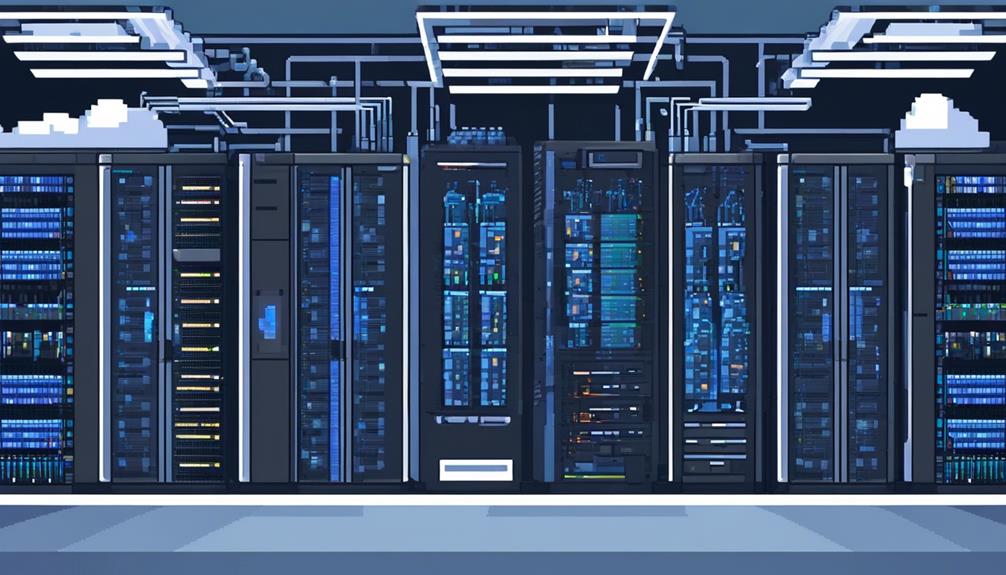Cloud data center hardware design is a critical aspect of establishing a robust and efficient infrastructure for cloud computing services. It involves careful consideration of various factors, such as:
- Hardware selection criteria
- Scalability
- High-performance computing options
- Redundancy
- Power and energy efficiency
- Rack and cabinet design
- Monitoring and management tools
- Disaster recovery
- Future-proofing
By meticulously addressing these aspects, organizations can ensure the seamless delivery of high-performance and highly available cloud services.
In this discussion, we will explore the intricate details of each of these components, uncovering the key considerations and best practices that drive the design of cloud data center hardware.
So, let's dive into the world of cloud data center hardware design and discover the fundamental elements that make it a vital cornerstone of modern computing infrastructure.
Key Takeaways
- Scalability and resource allocation efficiency are crucial considerations in cloud data center hardware design. This includes the use of modular hardware for easy expansion and contraction, scalable cable organization and management, and the incorporation of Software Defined Networking (SDN) for efficient resource partitioning.
- Elasticity, adaptability, and high-performance computing are important factors in hardware design. This involves modular builds for flexible scaling and adjustment of resources, consideration of power needs and efficient cooling systems, and evaluation of accelerated computing solutions and parallel processing alternatives.
- Redundancy, fault tolerance, and power/energy efficiency are essential in ensuring continuous operation and minimizing downtime. This includes duplicating critical components, implementing redundant power supplies and storage systems, having uninterruptible power supply (UPS) systems, and utilizing cooling systems and energy-saving technologies.
- Storage solutions and network infrastructure design are key components of cloud data center hardware design. This includes efficient disk arrays for high-speed access and fault tolerance, seamless integration of storage solutions with the data center design, selection and configuration of networking equipment, and implementation of security measures to protect against unauthorized access and cyber threats.
Hardware Selection Criteria
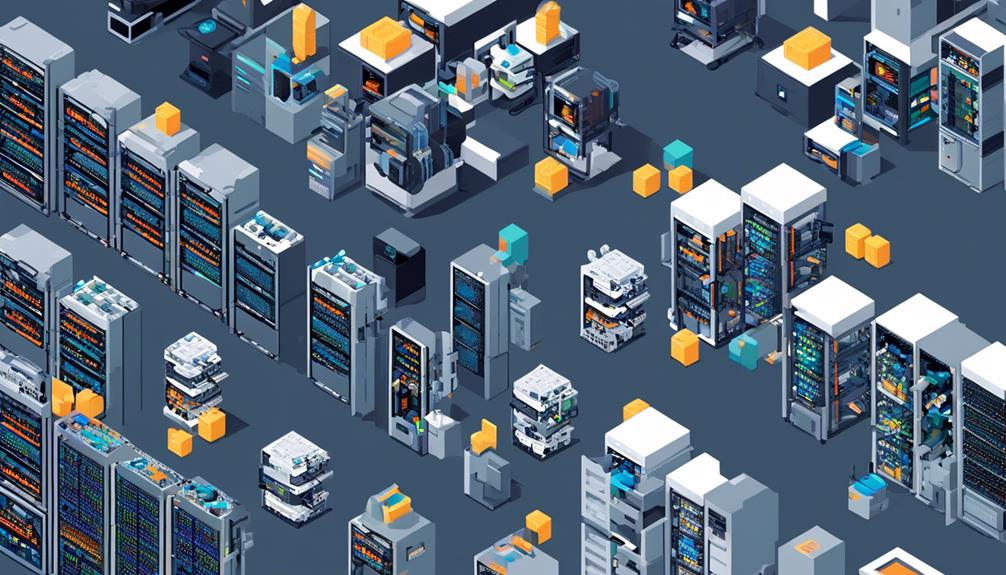
The selection of hardware for a cloud data center is a critical process that involves evaluating various criteria to ensure scalability, reliability, performance, compatibility, and cost-effectiveness. When designing a data center project, it is essential to consider the hardware components that will support the center's operations and meet the demands of its workloads.
Scalability is a key factor in hardware selection for a cloud data center. The hardware should have the flexibility to accommodate future growth and changes in demand. This includes the ability to add or replace components without causing disruptions to the center's operations. Additionally, the hardware should support virtualization technologies, allowing for the efficient allocation of resources and the scaling of services.
Reliability and redundancy are crucial for ensuring continuous operation and minimizing downtime. Redundant power supplies, storage systems, and network connections are essential to prevent single points of failure. Hardware components with built-in fault tolerance mechanisms, such as RAID configurations for storage, can provide additional resiliency.
Performance and efficiency are also important considerations. The hardware should have the processing power and memory capacity to handle the center's workloads effectively. Energy efficiency is also a critical factor, as it can significantly impact operational costs. Choosing hardware components with advanced power management features and optimizing the cooling infrastructure can help reduce energy consumption.
Compatibility with existing infrastructure and systems is another crucial criterion. The hardware should seamlessly integrate with the data center's networking infrastructure, storage systems, and management tools. This ensures smooth operation and minimizes the risk of compatibility issues.
Scalability Considerations
When designing a cloud data center, scalability considerations play a crucial role in ensuring resource allocation efficiency, elasticity, and adaptability.
The ability to scale up or down the resources based on demand is essential for meeting the changing needs of the users. This requires a modular approach in hardware design, allowing for easy expansion and contraction of the infrastructure without disrupting the existing operations.
Scalable cable organization and management, as well as the separation of power and data cables, enable smooth scalability in cabling systems, ensuring longevity and adaptability in the data center infrastructure.
Resource Allocation Efficiency
Scalability considerations play a crucial role in ensuring resource allocation efficiency in the design of cloud data center hardware.
Data center designers understand that data centers require the ability to seamlessly scale their resources to accommodate the growing demands of modern applications and services. This necessitates building a physical infrastructure that allows for the easy connection and disconnection of individual server units, enabling modular builds that can be expanded as needed.
In addition, scalability considerations extend to the design of power and data cabling systems, with a focus on separation and longevity to support future expansions. Cooling systems also play a vital role in resource allocation efficiency, with adiabatic cooling and liquid cooling solutions being relevant for maintaining optimal temperatures in a growing and evolving data center.
Furthermore, incorporating Software Defined Networking (SDN) into data center design best practices enables efficient resource partitioning and scalability.
Elasticity and Adaptability
Elasticity and adaptability are essential considerations in the design of data center hardware. This is to ensure seamless scalability and resource allocation efficiency. In the context of cloud computing, data centers need to be able to scale up or down to meet changing demands without compromising reliability and security.
Modular builds allow for easy scaling and adjustment of resources based on workload requirements. This flexibility enables data centers to efficiently allocate resources as needed. Furthermore, the ability to connect and disconnect individual units without disruption is crucial for adaptability. This allows for quick and seamless adjustments to the hardware configuration.
Additionally, it is important to consider the power needs and cooling units to manage heat generation due to equipment density. The heat generated by the hardware can impact equipment lifespan and overall performance. Therefore, efficient cooling systems must be implemented to maintain optimal operating conditions.
To ensure long-term adaptability, designers must also consider the longevity of cabling systems for future expansions. This involves using high-quality and scalable cabling solutions that can accommodate future hardware additions without the need for extensive rewiring.
High-Performance Computing Options
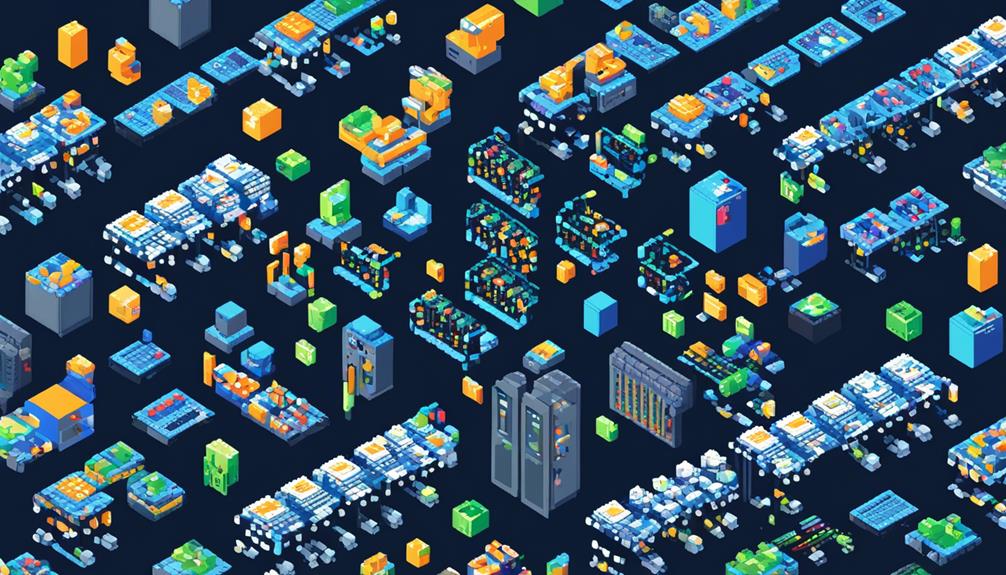
High-performance computing options in cloud data center hardware design include accelerated computing solutions and parallel processing alternatives.
Accelerated computing solutions utilize specialized hardware such as GPUs to efficiently perform complex computations.
Parallel processing involves dividing tasks into smaller parts for simultaneous execution on multiple processors, increasing overall performance.
These options should be carefully evaluated based on factors like scalability, memory bandwidth, and interconnect technology to ensure optimal performance for demanding workloads.
Accelerated Computing Solutions
Accelerated computing solutions, incorporating specialized hardware such as GPUs and FPGAs, are designed to process complex computational tasks at high speeds for applications like AI, scientific simulations, and financial modeling. These high-performance computing options leverage parallel processing and advanced algorithms to deliver significant performance gains for computationally intensive workloads.
Here are four key points to consider:
- Hardware Compatibility: Designing accelerated computing solutions requires careful consideration of hardware compatibility to ensure optimal performance and efficiency.
- System Architecture: The system architecture must be designed to accommodate the specialized hardware and facilitate efficient data processing and communication.
- Software Optimization: To maximize the performance benefits, software optimization techniques should be employed to leverage the capabilities of the specialized hardware.
- Industry Applications: Accelerated computing solutions find applications in research, scientific computing, and industries requiring rapid data analysis and real-time decision-making.
Parallel Processing Alternatives
With the growing demand for efficient processing of complex computational tasks, organizations are exploring parallel processing alternatives in high-performance computing options.
Distributed Memory Systems and Message Passing Interface (MPI) allow multiple nodes in a data center to work together by passing messages between them.
Shared Memory Systems and OpenMP, on the other hand, enable multiple processors within a single server rack to access a shared memory space.
GPU Computing utilizes graphics processing units to accelerate parallel processing tasks, making it ideal for computationally intensive workloads.
High-Performance Computing (HPC) clusters incorporate multiple servers with high-speed interconnects to achieve parallel processing capabilities.
FPGA-based accelerators utilize programmable logic to perform parallel processing tasks efficiently.
When designing the data center infrastructure, power demands, cooling and airflow, and energy efficiency should be considered, as well as the potential for future upgrades to accommodate parallel processing alternatives.
Redundancy and Fault Tolerance
Redundancy and fault tolerance are integral components of ensuring the uninterrupted operation of a cloud data center. To guarantee continuous data center services, the following strategies should be implemented:
- Redundant Components:
- Redundancy involves the duplication of critical components to prevent single points of failure.
- This includes redundant power supplies, network connections, and storage systems.
- By having multiple instances of these components, the data center can continue operating even if one fails.
- Uninterruptible Power Supply (UPS):
- A UPS system is essential for maintaining power continuity in case of a power outage.
- It provides backup power to keep the data center running until the main power source is restored.
- UPS systems are designed to provide seamless transition and prevent data loss or service interruption.
- Data Continuity Plan:
- A data continuity plan outlines the procedures and protocols to ensure data availability and accessibility in case of system failure or disaster.
- This plan includes backup and recovery strategies, disaster recovery sites, and data replication techniques.
- By having a well-defined data continuity plan, the data center can quickly recover from any disruptions and minimize downtime.
- Physical Security:
- Physical security measures are crucial for protecting the data center infrastructure from unauthorized access, theft, or damage.
- These measures include access control systems, surveillance cameras, and security personnel.
- By implementing robust physical security measures, the data center can prevent potential threats and maintain the integrity of its operations.
Power and Energy Efficiency
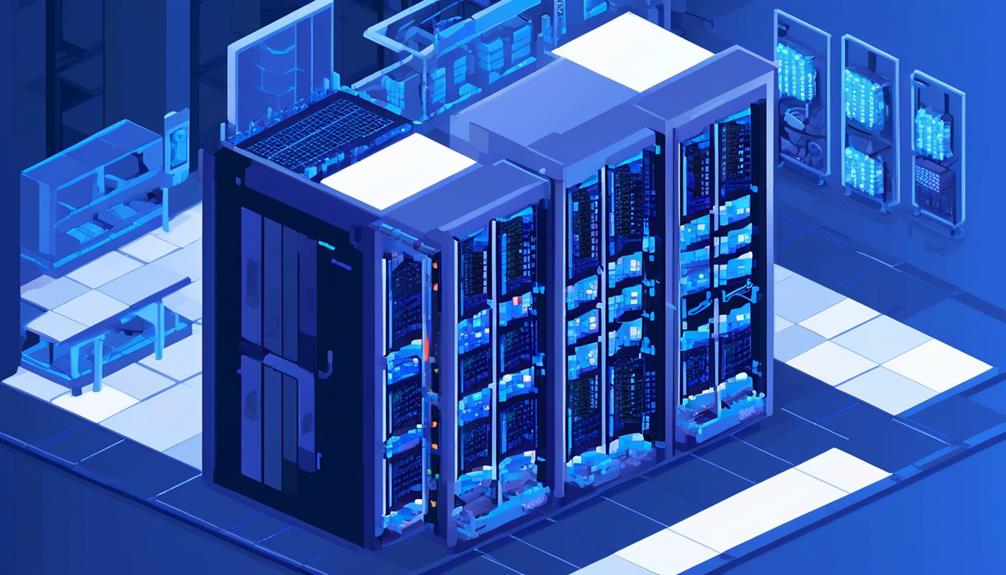
Power and energy efficiency are crucial considerations in the design and operation of a data center to ensure optimal performance and cost-effectiveness. Efficient management of power demands is essential to minimize energy consumption and reduce operational costs.
Data centers typically have high power demands in watts due to the large number of servers and networking equipment they house. To effectively distribute power, data centers use power distribution units (PDUs) that provide a reliable and scalable solution for power delivery.
In order to achieve an efficient data center, it is important to optimize power distribution and cooling systems. Cooling systems play a vital role in maintaining optimal temperatures and reducing energy consumption. Implementing effective airflow management and utilizing liquid cooling technologies can significantly improve energy efficiency. Additionally, considering the power draw of servers and optimizing cooling systems can further enhance power efficiency.
Monitoring and managing power usage efficiency is crucial for reducing energy consumption and minimizing costs. Data centers should track their power usage effectiveness, typically measured in watts per square foot, to identify areas for improvement. By regularly monitoring and analyzing power usage, data center operators can identify inefficiencies and make necessary adjustments to improve power efficiency.
Furthermore, data centers can enhance their energy efficiency by utilizing green energy sources and implementing energy-saving technologies. Incorporating renewable energy sources such as solar or wind power can help reduce the carbon footprint of data center operations. Additionally, data centers should consider using energy-efficient equipment and technologies that minimize input energy while maintaining optimal performance.
Storage Solutions
To effectively store and safeguard critical data within a data center environment, the choice of storage solutions becomes crucial, impacting performance, scalability, and data integrity for enterprise applications.
The following are key considerations when selecting storage solutions for a data center:
- Efficient Disk Arrays: Data center storage solutions encompass various subsystems, such as disk arrays, designed to efficiently store and protect critical data. These disk arrays should offer high-speed access, fault tolerance, and scalability to meet the demands of enterprise applications.
- Integration with Data Center Design: Storage solutions need to be seamlessly integrated with the overall data center design to ensure optimal functionality and accessibility. This includes considerations for cooling and heating air, cable and network design, security protocols, monitoring and management, and power and backup generators.
- Data Availability and Resilience: Implementing redundant and reliable storage solutions is essential to ensure data availability and resilience within the data center infrastructure. This includes features such as data replication, mirroring, and backup mechanisms to protect against hardware failures or data corruption.
- Scalability and Future-proofing: As data volumes continue to grow exponentially, storage solutions should provide scalability to accommodate future needs. This includes the ability to easily add additional storage capacity without disrupting operations or impacting performance.
Network Infrastructure Design
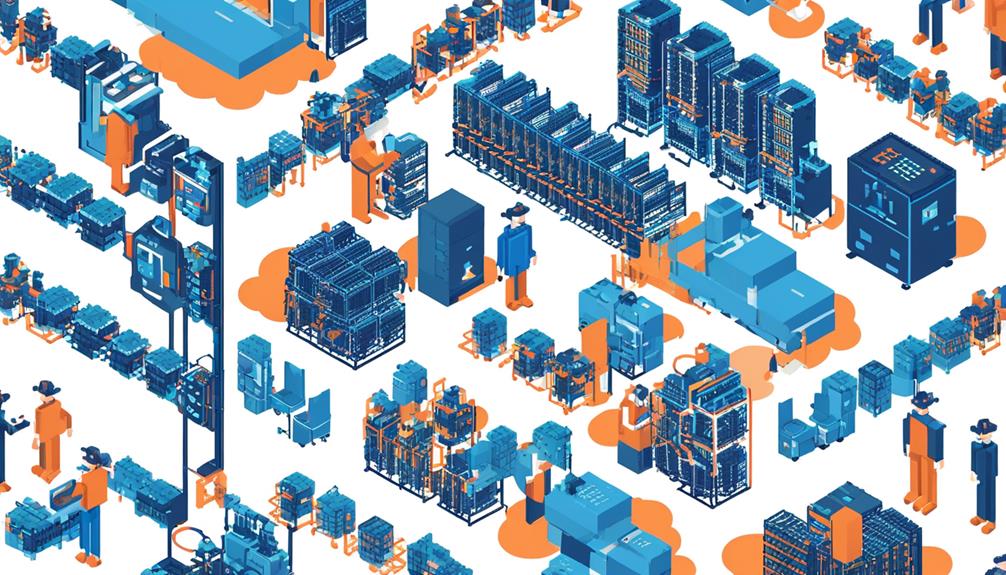
The design of a network infrastructure involves meticulous planning and implementation to ensure efficient data flow and seamless communication within a data center environment. A major aspect of data center design is the network infrastructure, which plays a crucial role in supporting the various operations and services within the data center.
A well-designed data center network is essential for efficient use of resources and the delivery of robust data services. Infrastructure management is a key consideration in building a data center network, as it involves the selection and configuration of networking equipment such as switches, routers, and firewalls. These components are carefully chosen to meet the performance and security requirements of the data center.
In addition to meeting performance and security needs, network infrastructure design also addresses the connectivity requirements for partners, carriers, and exchanges. This ensures seamless and reliable communication with external entities, enabling efficient data transfer and collaboration.
Security measures are an integral part of network infrastructure design. Firewalls, intrusion detection systems, and secure access controls are implemented to protect the data center network from unauthorized access and cyber threats. These security measures help safeguard sensitive data and ensure the integrity and confidentiality of information within the data center.
Efficient network infrastructure design also takes into account the physical aspects of the data center, including the layout and placement of networking equipment. Proper cable management and computer room air conditioning are essential to ensure optimal performance and minimize downtime.
Security Measures and Protocols
When it comes to security measures and protocols in cloud data center hardware design, encryption and authentication play a crucial role in safeguarding sensitive data.
Implementing robust encryption algorithms ensures the confidentiality and integrity of data both in transit and at rest.
Additionally, the use of strong authentication mechanisms, such as multi-factor authentication, helps prevent unauthorized access to the infrastructure.
Intrusion detection systems are also essential in detecting and responding to any potential security breaches, providing an additional layer of protection for the data center environment.
Encryption and Authentication
Encryption and authentication are crucial security measures and protocols employed within a data center to ensure the confidentiality and integrity of sensitive data. Here are four key points to consider when implementing encryption and authentication in a data center environment:
- Encryption: Data should be encrypted both at rest and in transit to protect it from unauthorized access. This involves encoding the data using cryptographic algorithms, making it unreadable without the correct decryption key. Encryption ensures secure transmission and storage of sensitive information.
- Authentication: Implementing strong authentication mechanisms is essential to verify the identity of users or devices accessing the data center. This prevents unauthorized access and ensures that only authorized individuals can access sensitive data.
- Best practices: Data center operators should follow industry best practices for encryption and authentication, such as using strong encryption algorithms, regularly updating encryption keys, and implementing multi-factor authentication.
- Physical barriers: In addition to digital security measures, physical barriers like restricted access to the server room and video surveillance systems should be in place to prevent unauthorized physical access to sensitive data.
Intrusion Detection Systems
Intrusion Detection Systems (IDS) are crucial security measures and protocols employed within a data center to monitor network traffic and systems for signs of unauthorized access or security breaches.
IDS can be either network-based, examining data packets, or host-based, monitoring activities on individual devices. These systems analyze traffic patterns, identify anomalies, and generate alerts or take action to prevent threats.
By deploying IDS, data center management can enhance data center security by detecting and responding to potential threats in real-time. IDS plays a crucial role in maintaining the integrity and confidentiality of data center resources by proactively identifying and mitigating security risks.
Whether building a new data center or upgrading an existing one, incorporating IDS is essential to meet regulatory and operational standards for data center security.
Cooling and Ventilation Systems
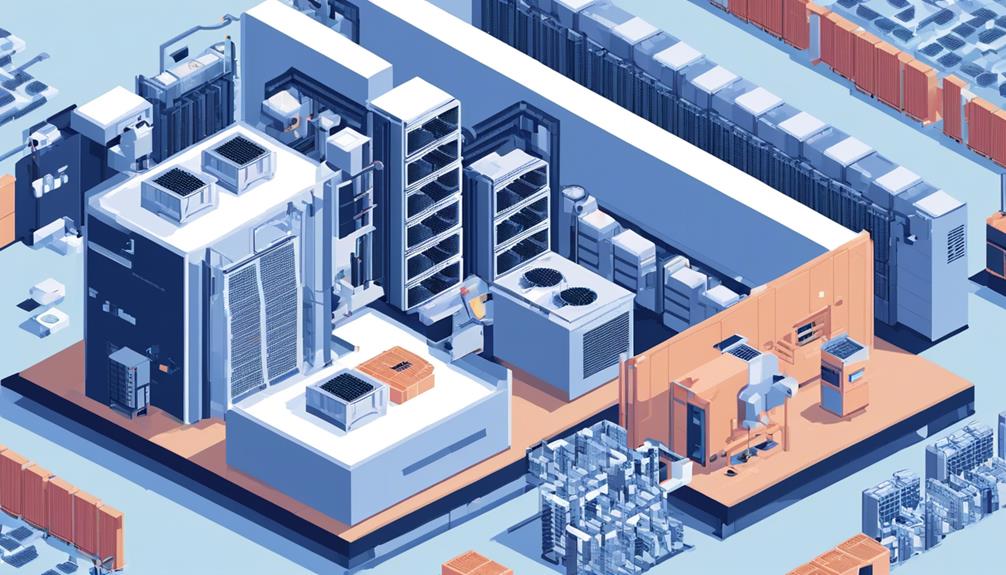
Effective cooling and ventilation systems are essential components in ensuring the optimal performance and longevity of data center hardware.
The heat generated by the IT infrastructure can significantly impact the equipment's lifespan, making it crucial to employ suitable cooling solutions.
Here are four key considerations for data center cooling and ventilation systems:
- Heat removal: Data centers generate substantial heat due to the high equipment density. Cooling systems play a critical role in removing this heat to maintain a stable operating temperature. Adiabatic cooling, such as airflow systems, and liquid cooling, like water-based solutions, are available options to manage heat impact effectively.
- Temperature control: Maintaining the right temperature is vital for the proper functioning of data center hardware. Cooling solutions should be designed to regulate the temperature within an acceptable range, typically between 18 to 27 degrees Celsius (64 to 80 degrees Fahrenheit). Precision cooling systems, such as Computer Room Air Conditioners (CRAC), ensure precise temperature control.
- Humidity management: Alongside temperature control, maintaining optimal humidity levels is crucial. Humidity levels between 40 to 60 percent are generally recommended for data centers to prevent equipment corrosion and electrostatic discharge. Data Center Infrastructure Management (DCIM) systems often include humidity sensors to monitor and manage humidity levels effectively.
- Airflow optimization: Proper airflow management is essential to prevent hotspots and ensure uniform cooling throughout the data center. Implementing hot and cold aisle containment strategies, using perforated tiles, and arranging server racks in a way that promotes optimal airflow can help optimize cooling efficiency and reduce energy consumption.
Rack and Cabinet Design
Properly designed racks and cabinets are crucial for organizing and housing the IT infrastructure within a data center, ensuring efficient space utilization and facilitating seamless maintenance and upgrades. Rack and cabinet design plays a significant role in data center design, contributing to effective infrastructure management. By implementing standardized rack and cabinet designs, data centers can streamline maintenance and management processes.
When designing racks and cabinets, several factors need to be considered, including airflow management, cable organization, and security measures. Efficient airflow is essential to prevent hot spots and maintain optimal operating temperatures for the IT equipment. Cable organization is vital for easy identification and troubleshooting, minimizing downtime during maintenance. Security measures such as locking systems and access controls protect sensitive data and equipment from unauthorized access.
To optimize data center performance, rack and cabinet design should align with cooling and power distribution strategies. High-density racks enable the accommodation of more IT equipment in a smaller footprint, maximizing space utilization. Proper power distribution within the racks ensures adequate power supply to each device while maintaining efficiency. Moreover, temperature and humidity monitoring systems should be integrated into the racks and cabinets to prevent equipment failures and ensure optimal operating conditions.
In the event of power outages, emergency power systems such as uninterruptible power supplies (UPS) and backup generators should be considered during rack and cabinet design. These systems provide temporary power to critical equipment, ensuring uninterrupted operation during emergencies.
To help illustrate the importance of rack and cabinet design, the following table provides an overview of the key considerations and their significance:
| Consideration | Significance |
|---|---|
| Airflow management | Prevents hot spots and maintains optimal operating temperatures |
| Cable organization | Minimizes downtime during maintenance |
| Security measures | Protects sensitive data and equipment |
| Power distribution | Ensures adequate power supply and efficiency |
| Temperature & humidity | Prevents equipment failures and ensures optimal conditions |
Monitoring and Management Tools
Monitoring and management tools are essential components for tracking and analyzing real-time performance within a data center infrastructure. These tools play a crucial role in ensuring the smooth and efficient operation of data center facilities.
Here are four key aspects of monitoring and management tools that make them indispensable in the design and operation of modern data centers:
- Resource Utilization Tracking: Monitoring tools provide insights into resource utilization within the data center, including server CPU usage, memory consumption, and storage capacity. This information helps data center administrators optimize resource allocation and identify potential bottlenecks.
- Power and Cooling Efficiency: Monitoring tools enable data center operators to monitor power consumption and cooling efficiency. This information is crucial for designing a data center that achieves net-zero energy consumption and minimizes carbon footprint. It also helps in identifying any inefficiencies in the cooling infrastructure, such as suboptimal airflow or overcooling.
- Proactive Issue Identification: Advanced monitoring tools come with automation features that enable proactive issue identification and response. They can detect anomalies in server performance, network connectivity, or cooling systems and alert administrators before these issues escalate into major problems.
- Historical Data Analysis: Monitoring tools facilitate historical data analysis, allowing data center operators to identify trends, forecast future resource requirements, and plan for capacity expansion. This capability is particularly important in ensuring optimal resource allocation and avoiding resource shortages or overprovisioning.
Disaster Recovery and Backup Solutions
Disaster recovery and backup solutions are crucial components of a comprehensive data center infrastructure, ensuring business continuity and minimizing the impact of data loss, system failures, or natural disasters. In data center hardware design, implementing a robust disaster recovery plan involves creating redundant backups of critical data and applications to minimize downtime and data loss. Backup solutions encompass various technologies such as tape backups, disk-based backups, cloud-based backups, and replication to remote sites for data redundancy.
To create a resilient and reliable environment, data centers often incorporate backup generators to provide uninterrupted power supply in the event of a power outage. Redundant communication paths are also established to ensure continuous connectivity. By designing a center that is fault-tolerant and highly available, businesses can minimize the risk of downtime and maintain seamless operations.
Additionally, data centers are increasingly focusing on environmental sustainability. To achieve net zero carbon emissions, centers employ innovative cooling techniques such as using outside air to cool computer systems. This not only reduces energy consumption but also contributes to a greener infrastructure.
Regular testing and validation of disaster recovery and backup solutions are crucial to ensure their effectiveness and reliability in real-world scenarios. By conducting periodic drills and simulations, data center operators can identify any vulnerabilities or gaps in the disaster recovery plan and make necessary adjustments. This proactive approach helps minimize the potential impact of unforeseen events and enables quick recovery.
Future-Proofing and Technology Advancements
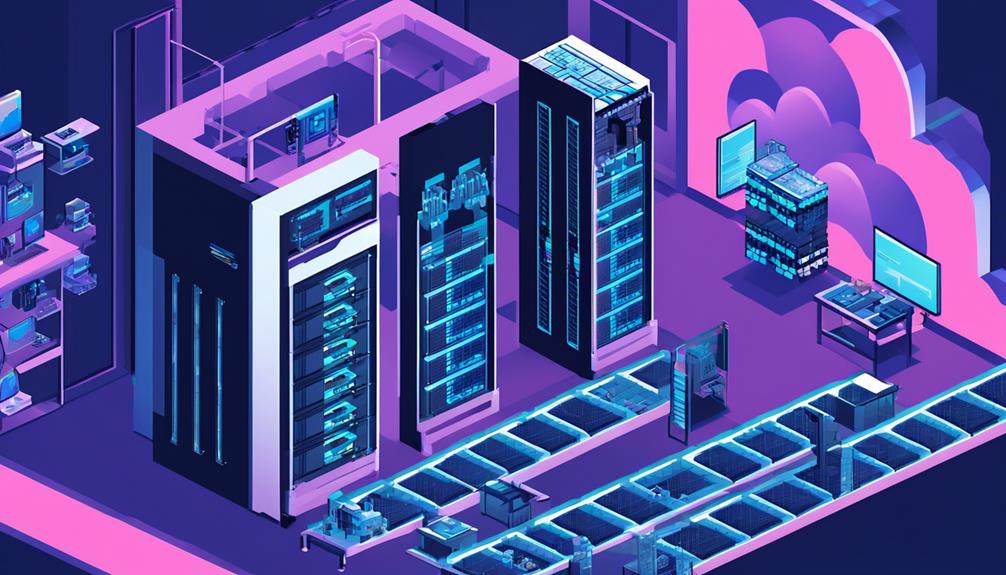
In order to ensure the long-term viability and compatibility of data center infrastructure with evolving IT advancements, future-proofing and technology advancements play a crucial role in the design and implementation of data centers. Here are four key considerations for future-proofing data center design:
- Scalable and adaptable modular builds: Data centers must be designed with the ability to scale seamlessly as demand grows. By implementing modular designs, additional space can be easily added without disrupting operations. This flexibility allows for efficient utilization of space and accommodates future growth.
- Integration of cutting-edge technology advancements: To stay ahead of the curve, data center designs need to incorporate the latest technology advancements. This includes leveraging advancements in power efficiency, airflow management, and equipment density. By embracing these innovations, data centers can optimize performance, reduce energy consumption, and mitigate heat-related challenges.
- Longevity and resilience of cabling systems: As technology advances, data transmission speeds increase, and cabling requirements change. It is essential to consider future-proof cabling systems that can accommodate higher speeds and bandwidth. By investing in resilient cabling infrastructure, data centers can avoid costly upgrades down the line.
- Efficient resource partitioning and management: With the ever-growing complexity of data center operations, efficient resource partitioning and management are crucial. Technologies like Software Defined Networking (SDN) enable dynamic resource allocation and optimization, allowing for better utilization of resources and improved agility in response to changing demands.
Frequently Asked Questions
What Hardware Is Used in Data Centers?
Data centers use a variety of hardware components including servers, storage devices, networking equipment, and backup power supply. The selection of hardware is crucial for efficient data center operations. Factors such as scalability, virtualization, and high-performance computing are important considerations.
Networking hardware plays a crucial role in establishing a robust and secure infrastructure. Energy efficiency is a key aspect of data center hardware design. Challenges in managing and maintaining hardware are also significant.
Future trends in data center hardware technology include advancements in scalability, virtualization, and energy efficiency.
What Are the 3 Main Components of a Data Center Infrastructure?
The three main components of a data center infrastructure are:
- The data center network architecture: This refers to the design and implementation of the network that connects servers, switches, routers, and other networking equipment.
- The storage infrastructure: This includes the storage devices and systems used to store and manage data.
- Power and cooling systems: These systems ensure the reliable and efficient operation of the data center by providing electricity and maintaining optimal temperature levels.
What Are the Two Main Aspects of Data Center Design?
When designing a data center, there are two main aspects to consider: scalability options and energy efficiency.
Scalability options refer to the ability of the data center to accommodate increasing demands for computing resources, storage, and network connectivity.
Energy efficiency involves implementing cooling systems, power supply redundancy, and other measures to optimize energy consumption.
Additionally, data center design should also address security measures, data storage solutions, server rack layout, and disaster recovery strategies to ensure the smooth and secure operation of the facility.
How Are Data Centers Designed?
Data centers are designed to meet the growing demands of modern enterprises. Key considerations include:
- Data center cooling techniques
- Energy efficiency
- Networking technologies
- Scalability
- Security measures
- Redundancy
- High availability strategies
- Virtualization
- Software-defined infrastructure
- Location selection factors
- Disaster recovery planning
These factors ensure optimal performance, reliability, and protection of critical data.

